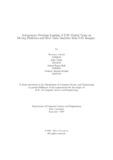| dc.contributor.advisor | Rhaman, Md. Khalilur | |
| dc.contributor.advisor | Alam, Md. Golam Rabiul | |
| dc.contributor.author | Ashrafi, Rezwana | |
| dc.contributor.author | Uddin, Jahir | |
| dc.contributor.author | Rafi, Suhail Haque | |
| dc.contributor.author | Raidah, Mashiat Mamun | |
| dc.date.accessioned | 2023-10-16T05:54:19Z | |
| dc.date.available | 2023-10-16T05:54:19Z | |
| dc.date.copyright | ©2022 | |
| dc.date.issued | 2022-09-28 | |
| dc.identifier.other | ID 17201043 | |
| dc.identifier.other | ID 22341091 | |
| dc.identifier.other | ID 18201004 | |
| dc.identifier.other | ID 18101359 | |
| dc.identifier.uri | http://hdl.handle.net/10361/21839 | |
| dc.description | This thesis is submitted in partial fulfillment of the requirements for the degree of Bachelor of Science in Computer Science and Engineering, 2022. | en_US |
| dc.description | Cataloged from PDF version of thesis. | |
| dc.description | Includes bibliographical references (pages 35-37). | |
| dc.description.abstract | UAVs have ignited our curiosity to understand the mechanism of flying and improve the way these vehicles fly to enable them to be of great benefit in a variety of ap-plications such as exploration, rescue, 3D mapping, military use, and many other applications. But these applications of drones face limitations due to short battery life, human interventions necessary to replace the battery, power consumption, and communication distance. The purpose of our research is to mitigate the challenges faced by UAVs by proposing an autonomous quadcopter that is able to land pre-cisely on a wireless charging station placed on a moving vehicle by motion tracking algorithm and increasing the accuracy of Helipad Detection and a Gazebo simulator capable of modelling an air traffic system for a swarm of drones by combining sensor values and control movement from the environment, as well as specifying the traffic system through path planning and collision avoidance. This study solves the short flight time of the soon to become one of the main components of the urban infrastructure air traffic system and ensures the variety of applications of these drones to be carried on for a safer and longer period of time and without any hazard. Aside from that, we will concentrate on factors such as water surface analysis, where we will look for water garbage in rivers and ocean bodies in Bangladesh. | en_US |
| dc.description.statementofresponsibility | Rezwana Ashrafi | |
| dc.description.statementofresponsibility | Jahir Uddin | |
| dc.description.statementofresponsibility | Suhail Haque Rafi | |
| dc.description.statementofresponsibility | Mashiat Mamun Raidah | |
| dc.format.extent | 48 pages | |
| dc.language.iso | en | en_US |
| dc.publisher | Brac University | en_US |
| dc.rights | Brac University theses are protected by copyright. They may be viewed from this source for any purpose, but reproduction or distribution in any format is prohibited without written permission. | |
| dc.subject | UAV | en_US |
| dc.subject | Digital twin | en_US |
| dc.subject | Precision landing | en_US |
| dc.subject | Mapping | en_US |
| dc.subject | Trash trap | en_US |
| dc.subject | AI | en_US |
| dc.subject | River image processing | en_US |
| dc.subject.lcsh | Remote sensing | |
| dc.subject.lcsh | Automotive engineering | |
| dc.title | Autonomous precision landing of UAV digital twins on moving platforms and river data analytics from UAV imagery | en_US |
| dc.type | Thesis | en_US |
| dc.contributor.department | Department of Computer Science and Engineering, Brac University | |
| dc.description.degree | B.Sc. in Computer Science and Engineering | |

